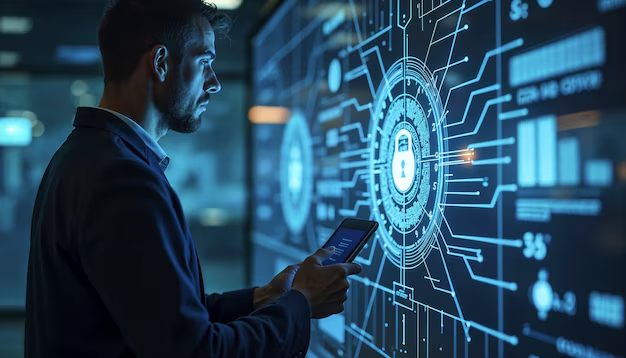Next Gen Biometric Security Tech has rapidly evolved over the years, offering advanced solutions for authentication and security across various industries. With cyber threats becoming more sophisticated, next-generation biometric security technology is focusing on improving accuracy, speed, and security. This article explores the latest innovations in biometric security and how they are shaping the future of digital identity and security.
Understanding Next Gen Biometric Security Tech
What Is Biometric Security?
Biometric security refers to authentication techniques that use unique physical or behavioral characteristics to identify individuals. These include fingerprints, facial recognition, iris scans, voice recognition, and even gait analysis.
Importance of Biometric Security
- Enhanced security – Biometrics are difficult to forge or steal.
- Convenience – Eliminates the need for passwords and PINs.
- Faster authentication – Provides quick and seamless identity verification.
- Personalized access – Ensures that only authorized individuals gain entry.
Latest Innovations In Next-Gen Biometric Security Tech
1. AI-Powered Facial Recognition
Artificial intelligence (AI) has significantly improved facial recognition technology, making it more accurate and resistant to spoofing attacks.
Key Advancements:
- Deep learning algorithms enhance recognition accuracy.
- 3D facial mapping improves identity verification.
- Liveness detection prevents spoofing with masks or photos.
2. Iris and Retina Scanning
Iris and retina scanning have become more advanced, offering highly secure authentication methods.
Key Advancements:
- High-speed recognition with minimal error rates.
- Infrared scanning for enhanced security.
- Mobile integration for on-the-go authentication.
3. Behavioral Biometrics

Behavioral biometrics analyze an individual’s unique patterns, such as typing rhythm, mouse movements, and touchscreen gestures.
Key Advancements:
- Continuous authentication rather than one-time verification.
- AI-driven analysis improves accuracy.
- Detects anomalies to prevent fraud.
4. Contactless Fingerprint Scanning
Traditional fingerprint scanners require physical contact, but next-gen biometric technology is moving towards contactless solutions.
Key Advancements:
- Uses high-resolution imaging to capture fingerprints without touch.
- Reduces hygiene concerns, especially in public spaces.
- Faster authentication with improved accuracy.
5. Voice Recognition with AI Enhancement
Voice recognition technology is improving with AI-driven enhancements for better accuracy and fraud detection.
Key Advancements:
- AI-powered noise reduction improves recognition in various environments.
- Multi-factor voice authentication enhances security.
- Real-time fraud detection using voice patterns.
6. Multimodal Biometric Authentication
Multimodal biometrics combines multiple biometric factors (e.g., facial recognition + fingerprint) for stronger security.
Key Advancements:
- Higher accuracy compared to single-factor authentication.
- Reduces the risk of spoofing attacks.
- Offers more flexible authentication options.
7. Blockchain and Biometric Security

Blockchain technology is being integrated with biometrics to create decentralized, tamper-proof identity verification systems.
Key Advancements:
- Decentralized identity storage reduces data breaches.
- Ensures privacy and security of biometric data.
- Improves user control over personal data.
8. Biometric Payment Systems
Biometric payment authentication is becoming more common, replacing passwords and PINs for transactions.
Key Advancements:
- Facial and fingerprint recognition for secure payments.
- Increased adoption in retail and banking sectors.
- Faster, seamless transactions without PINs or passwords.
9. Wearable Biometric Security Devices
Smartwatches and fitness trackers now incorporate biometric security features.
Key Advancements:
- Continuous authentication based on heart rate patterns.
- Secure access control for wearables.
- Integration with banking and healthcare applications.
10. Gait Recognition Technology
Gait recognition analyzes a person’s walking style for identity verification.
Key Advancements:
- Works from a distance, making it ideal for surveillance.
- Difficult to spoof compared to fingerprints and facial recognition.
- Used in law enforcement and security-sensitive areas.
Challenges and Limitations of Next-Gen Biometric Security
Despite these advancements, there are still challenges to address:
- Privacy concerns – Storing biometric data raises security risks.
- False positives and negatives – Even AI-driven systems are not 100% accurate.
- High costs – Implementing advanced biometric systems can be expensive.
- Regulatory issues – Compliance with data protection laws is crucial.
Future of Biometric Security

The future of biometric security is promising, with continuous innovations enhancing security and convenience. Some potential developments include:
- AI-driven adaptive authentication that learns user behavior.
- Biometric cryptography for highly secure transactions.
- Brainwave biometrics for advanced identity verification.
- Widespread adoption in smart cities and IoT devices.
Also Read: How Blockchain Advancements Are Enhancing Data Security?
Conclusion
Biometric security technology is evolving rapidly, offering enhanced security, convenience, and reliability. From AI-powered facial recognition to blockchain-based biometric security, the innovations in this field are reshaping how authentication works. As these technologies continue to advance, businesses and individuals must stay informed and adopt secure biometric solutions to protect sensitive information.
FAQs
1. How secure is biometric authentication?
Biometric authentication is more secure than traditional passwords, but it is not foolproof. Multi-factor authentication and encryption can further enhance security.
2. Can biometric data be hacked?
Yes, biometric data can be stolen or spoofed, but advanced technologies like liveness detection, AI-driven fraud detection, and blockchain storage help reduce risks.
3. What industries benefit most from biometric security?
Banking, healthcare, law enforcement, and smart home automation benefit significantly from biometric security innovations.
4. How is AI improving biometric security?
AI enhances biometric security by reducing false positives, improving recognition accuracy, detecting fraud attempts, and enabling continuous authentication.
5. What is the future of biometric security?
The future of biometric security includes AI-driven authentication, blockchain integration, biometric cryptography, and the use of brainwave biometrics for advanced security solutions.





